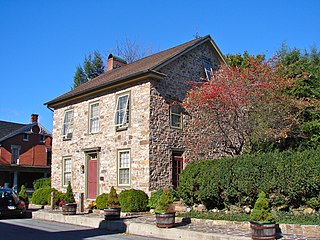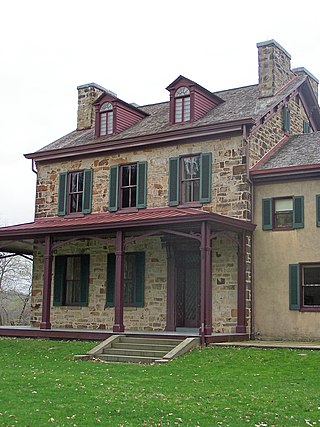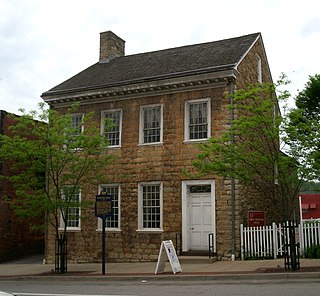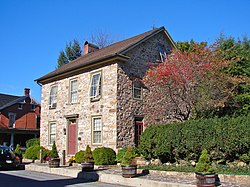
Dunbar Township is a township in Fayette County, Pennsylvania, United States. The population was 6,671 at the 2020 census, a decline from the figure of 7,126 tabulated in 2010.

Landisburg is a borough in Perry County, Pennsylvania, United States. The population was 220 at the 2010 census. It is part of the Harrisburg–Carlisle Metropolitan Statistical Area.

Scarsdale station is a commuter rail stop on the Metro-North Railroad's Harlem Line, located in Scarsdale, New York. Scarsdale is the southernmost station on the two-track section of the Harlem Line; a third track begins to the south.

Friendship Hill was the home of early American politician and statesman Albert Gallatin (1761–1849). Gallatin was a U.S. Congressman, the longest-serving Secretary of the Treasury under two presidents, and ambassador to France and Great Britain. The house overlooks the Monongahela River near Point Marion, Pennsylvania, about 50 miles (80 km) south of Pittsburgh.

Dunbar Gifted & Talented Education International Studies Magnet Middle School is a magnet middle school for students in grades 6 through 8 located in Little Rock, Arkansas, United States. Dunbar Magnet Middle School is administered by the Little Rock School District. It is named for the nationally known African-American poet, Paul Laurence Dunbar.

The David Bradford House is a historic house museum at 175 South Main Street in Washington, Pennsylvania. Completed in 1788, it was the home of David Bradford, a leader of the Whiskey Rebellion. It has both architectural and historic importance, and was designated a National Historic Landmark in 1983. It is open weekly between April and November, or by appointment.

The Isaac Meason House, also known as Mount Braddock, is a historic house located in Dunbar Township, Fayette County, Pennsylvania. Completed in 1802, it is one of only two surviving Palladian style stone mansions from the period in the United States. Isaac Meason, for whom it was built, was an American Revolutionary War hero and early political power broker in the area, becoming the richest person in Fayette County due to his interest in iron furnaces and possession of enslaved people. The house was designated a National Historic Landmark in 1990 for its architecture.

The Paul Laurence Dunbar House was the 1904–1906 home of poet Paul Laurence Dunbar in Dayton, Ohio. It is a historic house museum owned by the state of Ohio and operated by Dayton History on behalf of the Ohio Historical Society; it is also part of Dayton Aviation Heritage National Historical Park. It is located at 219 Paul Laurence Dunbar Street in Dayton.

The Dunbar Hospital was the first hospital for the black community in Detroit, Michigan, United States. It is located at 580 Frederick Street, and is currently the administrative headquarters of the Detroit Medical Society. It was listed on the National Register of Historic Places in 1979.

The Dunbar–Stearns House is a historic house at 209 Linden Street in Waltham, Massachusetts. This 2+1⁄2-story wood-frame house was built c. 1846 by Peter Dunbar, and was originally Greek Revival in character. It had a fully pedimented gable, with a single-story porch that was supported by columns that apparently wrapped around the building. The house was purchased in 1892 by Joseph Stearns, who had the house completely remodeled to achieve its present Queen Anne styling. It was enlarged to the sides by incorporating the area of the side porticos, a turret was added to the front, and the pedimented gable was covered with decorative shingle styling. Interior alterations into the new style were equally extensive.

The Dunbar-Vinton House is a historic house at Hook and Hamilton Streets in Southbridge, Massachusetts, USA. Probably built in the early 19th century, it is locally unusual for its brick construction at that time, and may have been built as a district schoolhouse. It was listed on the National Register of Historic Places in 1989.

The Claysville "S" Bridge is a historic S bridge in Washington County, Pennsylvania. The bridge is made of stone and was a part of the Cumberland Road and helped transport wagons and stagecoaches amid the American westward expansion in the early 19th century. It passes over Buffalo Creek.
David S. Creigh House, also known as the "Montescena" and Boone Farm, is a historic home located near Lewisburg, Greenbrier County, West Virginia. Although the house has "outstanding architectural features", it is most known for being the site of the 1863 death of a Union soldier which led to the execution of David S. Creigh, the owner, in 1864.
John W. Dunn was an architect and master builder in West Virginia.

The 1803 House, also known as the Jacob Ehrenhardt Jr. House, is a historic home in Emmaus, Pennsylvania, US, built in 1803 for Jacob Ehrenhardt Jr., a son of one of the town's founders.

The Paul Laurence Dunbar School is an historic, American school building that is located in the Templetown neighborhood of Philadelphia, Pennsylvania.

Mabel Pugh (1891–1986) was an art teacher, painter, woodblock printmaker and illustrator.

The Paul Laurence Dunbar School Neighborhood Historic District encompasses a historical neighborhood area of central Little Rock, Arkansas. Primarily developed between 1890 and 1915, the area was initially racially integrated, but had by the mid-1960s become predominantly African-American. It is anchored at the northern end by the Dunbar School campus, and extends south for 6-1/2 blocks along South Cross and South Ringo Streets. Prominent houses in the district include the Miller House, the Womack House, and the Scipio A. Jones House.

The George Dunbar House is a historic house in Nogales, Arizona. It was built in 1918 for George W. Dunbar, a real estate developer who built 75 houses in Nogales, Arizona and a dozen more in Nogales, Sonora across the Mexico–United States border. The house was designed in the American Craftsman architectural style. It has been listed on the National Register of Historic Places since August 29, 1985.




















